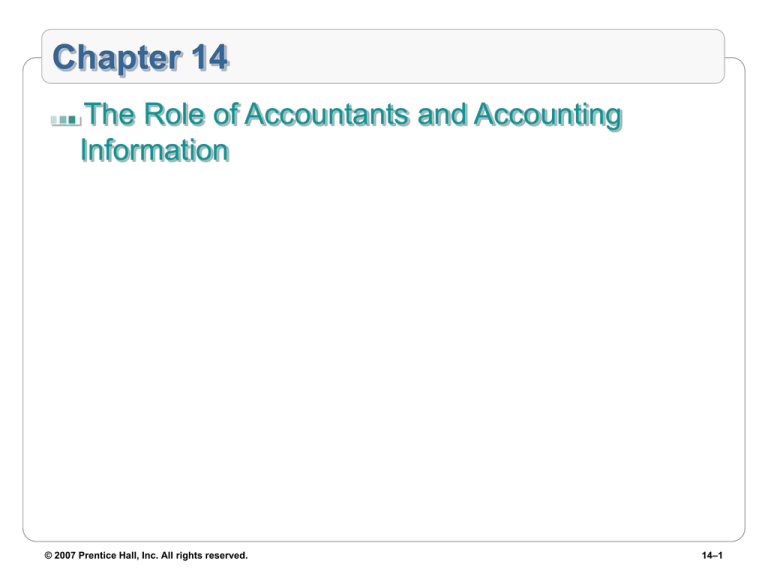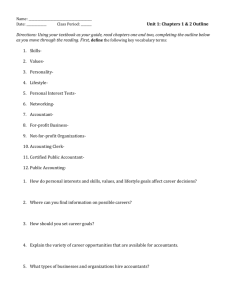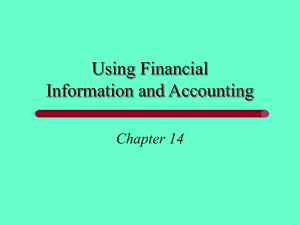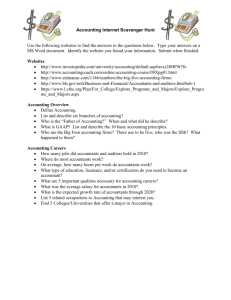
Chapter 14
The Role of Accountants and Accounting
Information
© 2007 Prentice Hall, Inc. All rights reserved.
14–1
LEARNING OUTCOMES
After reading this chapter, you should be able to:
Explain the role of accountants and distinguish between the kinds
of work done by public accountants, private accountants,
management accountants, and forensic accountants.
Explain how the accounting equation is used.
Describe the three basic financial statements and show how they
reflect the activity and financial condition of a business.
Explain the key standards and principles for reporting financial
statements.
Describe how computing financial ratios can help users get more
information from financial statements to determine the financial
strengths of a business.
Discuss the role of ethics in accounting.
© 2007 Prentice Hall, Inc. All rights reserved.
14–2
What’s in It for Me?
By understanding this chapter’s discussion of
accountants, their methods, and their
responsibilities, you’ll benefit in three ways:
1. if you’re thinking about starting your own business,
you’ll discover your obligations for reporting your
firm’s financial status
2. As an employee or union member, you’ll see how to
evaluate your company’s financial condition and its
prospects for the future
3. As an interested citizen, you’ll learn about
accounting ethics and regulatory requirements for
maintaining public trust in the business system
© 2007 Prentice Hall, Inc. All rights reserved.
14–3
What Is Accounting?
Accounting Defined:
A comprehensive system for collecting, analyzing
and communicating financial information
Bookkeeping: the recording of transactions
Users of Accounting Information:
Business managers
Employees and unions
Investors and creditors
Tax authorities
Government regulatory agencies
© 2007 Prentice Hall, Inc. All rights reserved.
14–4
Who Are Accountants
and What Do They Do?
Controller
Manages all of a firm’s accounting activities
Types of Accounting Systems
Financial Accounting
Concerned with external information users—the firm’s
external stakeholders
Prepares income statements, balance sheets, and other
financial reports published for shareholders and the public
Managerial (Management) Accounting
Serves internal users (managers) by providing information to
make departmental decisions, monitor projects, and plan
future activities
© 2007 Prentice Hall, Inc. All rights reserved.
14–5
Who Are Accountants and
What Do They Do? (cont’d)
Certified Public Accountants (CPAs)
Licensed, offering services to the public
Auditing (GAAP)
Tax services
Management advisory services
Noncertified Public Accountants
Private Accountants
Work exclusively for a firm as accountants
Management Accountants
Certified management accountant (CMA)
© 2007 Prentice Hall, Inc. All rights reserved.
14–6
Who Are Accountants and
What Do They Do? (cont’d)
Forensic Accountants
Assist in the investigation of business and financial
issues that may have application to a court of law
Investigative Accounting
Identifying financial evidence that may be pertinent
Analyzing financial evidence
Presenting accounting conclusions and their legal
implications
Litigation Support
Certified Fraud Examiner: A specialty area within forensic
accounting
© 2007 Prentice Hall, Inc. All rights reserved.
14–7
The CPA Vision Project
Identifying issues for the future
Global forces as drivers of change
Recommendations
A new direction
Core services
Core competencies
© 2007 Prentice Hall, Inc. All rights reserved.
14–8
Federal Restrictions on CPA Services
and Financial Reporting: Sarbox
Sarbanes-Oxley Act of 2002 (Sarbox)
Enacted to restore public trust in corporate
accounting practices as a direct response to
corporate financial abuses
Restricts non-audit services that CPAs can provide
Sarbox Compliance Requirements
CFOs and CEOs must pledge that the company’s
finances are correct and face severe penalties
noncompliance
Whistleblowers must be protected
© 2007 Prentice Hall, Inc. All rights reserved.
14–9
The Accounting Equation
The Accounting Equation
Assets = Liabilities + Owners’ Equity
Assets – Liabilities = Owners’ Equity (or Net Worth)
Asset
Any economic resource that is expected to benefit a
firm or an individual who owns it
Liability
A debt that the firm owes to an outside party
Owners’ Equity
Money that owners would receive if they sold all of a
company’s assets and paid all of its liabilities
© 2007 Prentice Hall, Inc. All rights reserved.
14–10
Financial Statements
Balance Sheets
Supply detailed information about:
Assets
– Current assets: Cash/assets that can be converted into cash
within a year
– Fixed assets: Capital that has long-term use or value
– Intangible assets: Patents, trademarks, copyrights, etc.
Liabilities
– Current liabilities: debts that must be paid within one year,
including accounts payable
– Long-term liabilities: debts not due for at least a year
Owners’ Equity
– Paid-in (invested) capital
– Retained earnings (net profits)
© 2007 Prentice Hall, Inc. All rights reserved.
14–11
Financial Statements (cont’d)
Income Statement (Profit and Loss Statement)
Its description of revenues and expenses results in a
figure showing the firm’s annual profit or loss
Revenues: the funds that flow into a business from the sale
of goods or services
Cost of revenues: shows the costs of obtaining the
revenues from other companies during the year
Cost of goods sold: costs of obtaining materials to make
products sold during the year
Gross profit: considers revenues and cost of revenues from
the income statement
Operating expenses: resources that must flow out of a
company if it is to earn revenues
© 2007 Prentice Hall, Inc. All rights reserved.
14–12
Financial Statements (cont’d)
Statements of Cash Flows
Describes yearly cash receipts and cash payments
Cash Flows from Operations: Concerns main operating
activities: cash transactions involved in buying and selling
goods and services
Cash Flows from Investing: Net cash used in or provided
by investing
Cash Flows from Financing: Net cash from all financing
activities
The Budget
A detailed report on estimated receipts and
expenditures for a future period of time
© 2007 Prentice Hall, Inc. All rights reserved.
14–13
Financial Statements Review
Balance Sheet
Assets – Liabilities = Owners’ Equity
Income Statement
Revenues – Expenses = Profit (or Loss)
Statement of Cash Flows
Cash In and Cash Out
Budget
Estimate – Actual = Variance
© 2007 Prentice Hall, Inc. All rights reserved.
14–14
Reporting Standards and Practices
Generally Accepted Accounting Principles
(GAAP)
Revenue recognition: Formal recording and reporting
of revenues at the appropriate time
Full disclosure
Financial statements should not include just numbers but
should also furnish management’s interpretations and
explanations of those numbers so that users can better
understand information in the statements
© 2007 Prentice Hall, Inc. All rights reserved.
14–15
Solvency Ratios
Short-Term
Current Ratio:
Current Assets
Current Liabilities
Leverage: The ability to finance an investment
through borrowed funds
© 2007 Prentice Hall, Inc. All rights reserved.
14–16
Solvency Ratios
Long-Term
Debt to Owners’ Equity Ratio:
Debt
Owners’ Equity
© 2007 Prentice Hall, Inc. All rights reserved.
14–17
Profitability and Activity Ratios
Return on Equity:
Net Income
Total Owners' Equity
Net Income
Earnings Per Share:
Inventory Turnover Ratio:
# of Shares Outstanding
Cost of Goods Sold
Average Inventory
© 2007 Prentice Hall, Inc. All rights reserved.
14–18
Bringing Ethics into the
Accounting Equation
Why Accounting Ethics?
To maintain public confidence in business
institutions, financial markets, and the products and
services of the accounting profession
AICPA’s Code of Professional Conduct
Maintained and enforced by the AICPA
The AICPA identifies six ethics-related areas with
which accountants must comply to maintain
certification
© 2007 Prentice Hall, Inc. All rights reserved.
14–19
Overview of the Code of Ethics for CPAs
Membership in the American Institute of Certified Public
Accountants is voluntary. By accepting membership, a
certified public accountant assumes an obligation of selfdiscipline above and beyond the requirements of laws and
regulations.
• Responsibilities
• The Public Interest
• Integrity
• Objectivity and Independence
• Due Care
• Scope and Nature of Services
© 2007 Prentice Hall, Inc. All rights reserved.
14–20




